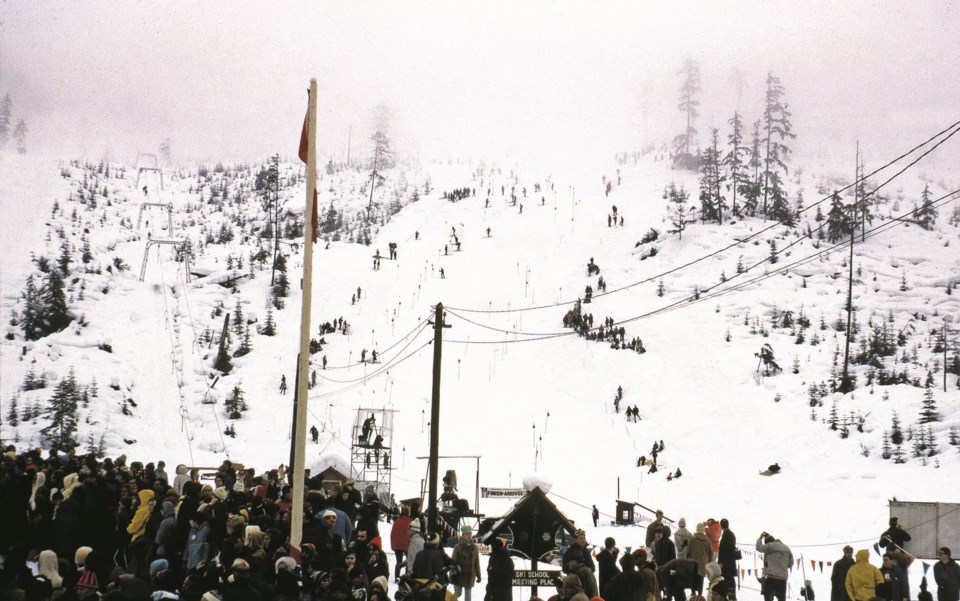Just over a year after Whistler Mountain opened in 1966, the Garibaldi Olympic Development Association (GODA) hosted the second annual du Maurier International—an event that brought top ski racers from around the world to Whistler.
The competition was a test to see if Whistler could handle a race of such a calibre, in hopes of eventually hosting the Olympics.
So, how did the first international ski race at Whistler go? Thanks to the publication Ski Trails, we have the full coverage of the event.
The du Maurier International was created in partnership with the Canadian Amateur Ski Association (CASA) and du Maurier Cigarettes. The cigarette company saw the potential for advertising and promotion through skiing events. After receiving approval from the Federation International de Ski (FIS), the first competition was held in 1966, and was split in two halves at different locations, Mt. Norquay (Alberta) and Mont-Sainte-Anne (Quebec). The race consisted of two disciplines, slalom and giant slalom, in both men’s and women’s categories.
The Whistler event took place Jan. 28 and 29, 1967. CASA was responsible for organizing it, while du Maurier Cigarettes sponsored the promotion and transportation for the athletes. Because the resort was fairly new with limited resources, there was a lot of planning and consideration for racers and spectators.
Luckily, it was a big snow year, and the courses were well-packed and many racers complimented the construction. Aside from Canadian skiers, the race drew professional athletes from the United States, Austria, France, Switzerland, Italy, Norway, Sweden, West Germany, and Finland.
Spectators were charged an entry fee of $1 or $2 if they chose to use the gondola to view the race. Transportation options from Vancouver were a train via the Pacific Great Eastern Railway, or a bus via Squamish Coachlines, GODA Charters, or Greyhound. Driving was an option, but parking at today’s Creekside area was limited. The event organizers had parking available at Brandywine Falls, with a shuttle ready to transport the public to the base of the mountain. Though the organizers ensured there were extra trains and buses, transport did not go as smoothly as expected.
On both days, the giant slalom was scheduled at 9:30 a.m. and the slalom at 1 p.m. Some trains arrived halfway through the first race, and some buses did not leave Vancouver to make the two-hour journey until 8 a.m. As the race started at mid-station, it took about 30 minutes to hike up to the area, and by that time many spectators did not see much. The slalom was at the base of the mountain and easier to view.
The race results were particularly exciting for Canadians. Nancy Greene placed first in both races, beating France’s Christine Goitschel by two seconds in the slalom, and Switzerland’s Ruth Adolf by four seconds in the giant slalom. In the men’s category, Norway’s Haakon Mjoen won slalom and Austria’s Werner Bleiner won giant slalom, though Canadian Peter Duncan placed fifth in both races.
Did Whistler pass the test? Yes and no. Hosting Whistler’s first international skiing event proved the mountain terrain was capable of holding Olympic-level competitions; however, the resort still did not have enough resources to accommodate the athletes and number of spectators. The success of the event strengthened GODA’s 1976 Olympic bid, which, due to a few factors, ultimately went to a previous host, Austria.
The summer Olympics was scheduled to be in Montreal, and the International Olympic Committee (IOC) did not want to have two Olympics back-to-back in the same country. After awarding the bid to Denver, Colo., it was rejected by the state due to environmental concerns. Whistler was reconsidered, but the new NDP provincial government did not support the bid. Though disappointing, it gave Whistler more time to develop its resources.




